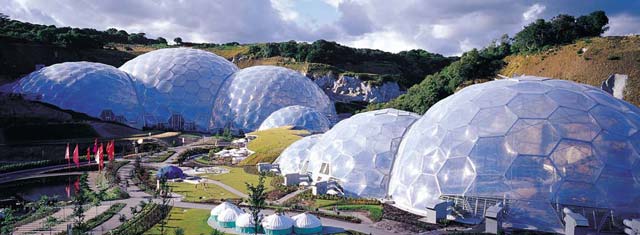
Adventuring in Brotherhood
[Adapted from Compass, the British Section TS circular, Winter 2004; more information available at www.edenproject.com.]
Is there anybody out there who doesn't, in quiet moments, feel in his or her heart that the future lies in working with the grain of nature? We are creatures. We may live in concrete burrows, and cover ourselves in a million different ways, and talk about our command over all we survey. Yet nothing can disguise the fact that we are part of nature, indivisible from it. -- Dr. Tony Kendle
The Eden Project, near St. Austell in Cornwall, England, is an educational, scientific, and research charity that occupies what was once a disused china-clay pit, an ugly scar on the landscape which has now acquired a new and beautiful life. Its mission statement is: "To promote the understanding and responsible management of the vital relationship between plants, people, and resources leading to a sustainable future for all." Dr. Kendle, one of its founders, describes it as "the stage on which we explore our interdependence with plants . . . It is not a theme park, it is about serious issues. It is intended to be optimistic, celebrating what is good and positive about possible futures, inspiring us to examine the world afresh." Elsewhere he elaborates:
Yes, humans have caused lots of problems in the world, but there are also places where we have lived in harmony with nature without complete destruction, and sometimes with a beneficial effect. Many of the challenges that lie ahead can only be met by people being there, not by their walking away. Communities have already begun to make steps to be effective stewards of the world. The Eden Project is here to showcase those steps.
We're also here to show that environmental awareness is about quality of life, at all levels. The 'environment' is shorthand for issues that impact on us in a thousand ways every day, from the food we eat and the clothes we wear to the weather we enjoy or suffer. Understanding our world better, and the part we play in it, is also about having fun, not about living grey, hair-shirt lives. It is about celebrating the beauty and richness, both natural and man-made, of other countries besides our own.
The floor of the pit has been transformed and is now occupied by two gigantic biodomes, unique greenhouses in which are created respectively rain forest and Mediterranean conditions. Within them are plants and trees appropriate to those climate zones whilst outside the landscape is planted with a wide range of trees, shrubs, and vegetables from around the world, many grown from seed. In all, there are over 100,000 plants representing 5,000 species. The temperature and humidity within the biodomes are controlled using natural energy. There is also an integrated pest management system using biological control through birds, frogs, lizards, and beneficial insects.

As we wander through the forests and plantations, the interrelationship between plants and ourselves becomes obvious. We start to realize, for example, how the potato from the Andes -- which in its homeland comes in black, orange, dark red, striped, knobbly, and smooth forms -- is still being used today in breeding programs to produce disease-resistant crops, and that its being made into crisps and chips helps to bring income and economic stability to local people. Again, take coffee or cacao -- these crops need shade, and by growing them under trees such as Prunus Africana (used to treat prostate cancer) a tiered production system emerges. As the trees grow bigger the garden once more becomes a productive crop forest, good for the local people, the economy, and the land. Nearer to home, in the temperate biodome we can find the sunflower, originally from North America, which provides food, fuel, and pigment. In Europe we associate sunflowers with the Mediterranean, but large scale commercial growing is principally in the Argentine, Ukraine, and Russia where sunflower oil was first commercially exploited. The seeds provide protein-rich food and margarine, as well as having uses in paint manufacture, medicines, cosmetics, and plastics. The remaining seed meal feeds livestock, and the husks and stems can be used to fuel the oil extraction.
But it does not stop there. Eden is not a world in isolation; it is deeply rooted in the local Cornish community. It aims to bring people together and inspire them to action, to "encourage us to think that idealistic need not be the same as naive." As Tim Smit, who originated the project, remarks:
we want you to leave here feeling that we all could make a very real difference to the world we live in if we could work together. In a world of -isms and -ologies, of expertise so refined that only experts understand it, we have brought together scientists, artists, and technologists to create a distinctive culture, one that makes the possibilities of the future come to life in a way that we can all comprehend.
This fascinating project shows us clearly that we are part of a whole, governed by the same laws of nature, and that our future is assured so long as we are prepared to be co-workers with nature.
(From Sunrise magazine, February/March 2005; copyright © 2005 Theosophical University Press)
In every person who comes near you look for what is good and strong; honor that; try to imitate it, and your faults will drop off like dead leaves when their time comes. -- John Ruskin